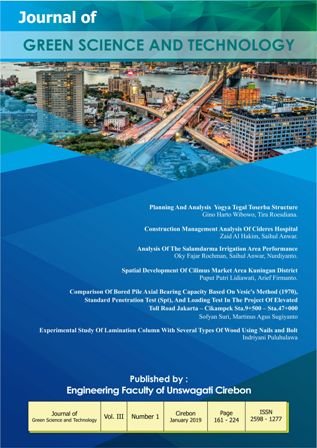EXPERIMENTAL STUDY OF LAMINATION COLUMN WITH SEVERAL TYPES OF WOOD USING ADHESIVE NAILS AND BOLT
DOI:
https://doi.org/10.33603/jgst.v3i1.2152Abstract
The use of light wood combined with heavy wood can improve the quality of the combinationwood. Apart from being used as laminated beams, a combination of light wood and heavy wood can also be used as a laminated column given compressive loads. Based on SNI 7973-2013, the adhesive that was permitted on built up columns or laminated columns can be in the form of bolts and nails, so this study has also used adhesive nails and bolts. This study purpose to determine the compressive capacity of the laminated column which combines several types of wood. The specimens made were four variations of the laminate column. Furthermore, three layers of wood have been used on one laminated column with heavy wood types on the outermost layer. The results showed that all variations of the laminated column had a higher compressive capacity than the solid column.
Â
Keywords: compressive capacity, lamination column, light and heavy wood
References
Awaludin ali. 2011. Penelitian sifat-sifat fisika dan mekanika kayu Glugu dan Sengon kawasan Merapi dalam rangka mempercepat pemulihan ekonomi masyarakat Merapi pasca letusan Merapi 2010. Diakses tanggal 10 Maret 2016, awaludin.staff.ugm.ac.id/files/2011/03
Fengky S.Y. 2015. Modulus elastisitas dan kekuatan lentur balok kayu laminasi. Jurnal Rekayasa Sipil Vol.11 No.1, 40-43
Indriyani P. 2018. Pengaruh posisi, jumlah layer dan mutu kayu terhadap balok laminasi kayu Mahang dan kayu Meranti. Jurnal Gradasi Vol.2 No.1, 52-60.
Lezian A, dkk. 2009. Pengaruh rasio bambu Petung dan kayu Sengon terhadap kapasitas tekan kolom laminasi. Jurnal teknologi dan kejuruan Vol.32 No.1, 71-78
SNI 7973-2013. 2013. Spesifikasi desain untuk konstruksi kayu. Badan Standarisasi Nasional (BSN).
Downloads
Published
Issue
Section
Citation Check
License
- Authors retain copyright and grant the journal right of first publication with the work simultaneously licensed under a Creative Commons Attribution-ShareAlike 4.0 International License that allows others to share and adapt the work with an acknowledgement of the works authorship and initial publication in this journal.
- Authors are able to enter into separate, additional contractual arrangements for the non-exclusive distribution of the journals published version of the work (e.g., post it to an institutional repository or publish it in a book), with an acknowledgement of its initial publication in this journal.
- Upon receiving the proofs, the Author/Editor agrees to promptly check the proofs carefully, correct any errors, and authorize the publication of the corrected proofs.













